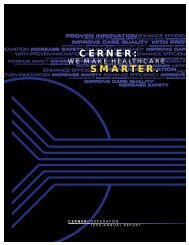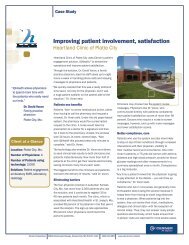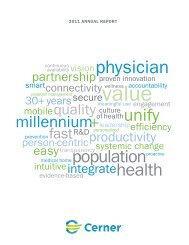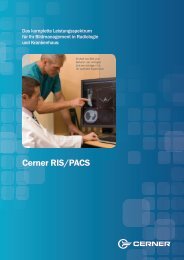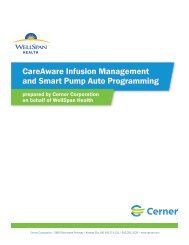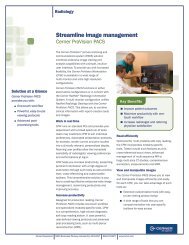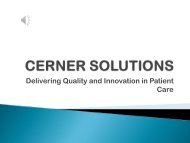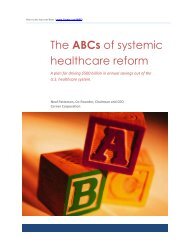The ABCs of systemic healthcare reform - Cerner Corporation
The ABCs of systemic healthcare reform - Cerner Corporation
The ABCs of systemic healthcare reform - Cerner Corporation
- No tags were found...
Create successful ePaper yourself
Turn your PDF publications into a flip-book with our unique Google optimized e-Paper software.
PART I<br />
Item 1. Business<br />
Overview<br />
<strong>Cerner</strong> <strong>Corporation</strong> (“<strong>Cerner</strong>” or the “Company”) is a Delaware business corporation formed in 1980. <strong>The</strong> Company’s corporate<br />
headquarters are located at 2800 Rockcreek Parkway, North Kansas City, Missouri 64117. Its telephone number is 816.221.1024. <strong>The</strong><br />
Company’s Web site address, which is used by the Company to communicate important business information concerning the Company,<br />
can be accessed at: www.cerner.com. <strong>The</strong> Company makes available free <strong>of</strong> charge, on or through its Web site, its annual report on Form<br />
10-K, quarterly reports on Form 10-Q, current reports on Form 8-K and all amendments to those reports as soon as reasonably practicable<br />
after such material is electronically filed with or furnished to the Securities and Exchange Commission.<br />
<strong>Cerner</strong> is a supplier <strong>of</strong> <strong>healthcare</strong> information technology (HIT) solutions, <strong>healthcare</strong> devices and related services. Organizations ranging<br />
from single-doctor practices, to hospitals, corporations, and local, regional and national governments use <strong>Cerner</strong> ® solutions and services to<br />
make <strong>healthcare</strong> safer, more efficient and <strong>of</strong> higher quality.<br />
<strong>The</strong> Company’s s<strong>of</strong>tware solutions have been designed and developed on the unified <strong>Cerner</strong> Millennium ® architecture. This person-centric<br />
solution framework combines clinical, financial and management information systems. It provides secure access to an individual’s<br />
electronic medical record at the point <strong>of</strong> care and organizes and proactively delivers information to meet the specific needs <strong>of</strong> the<br />
physician, nurse, laboratory technician, pharmacist or other care provider, front- and back-<strong>of</strong>fice pr<strong>of</strong>essionals and even consumers.<br />
<strong>The</strong> Company’s CareAware architecture extends these links by connecting information from various devices to the clinician workflow and<br />
electronic medical record.<br />
<strong>Cerner</strong> also <strong>of</strong>fers a broad range <strong>of</strong> services, including implementation and training, remote hosting, operational management services,<br />
support and maintenance, <strong>healthcare</strong> data analysis, clinical process optimization, transaction processing, employer clinics and employer<br />
health plan third party administrator (TPA) services.<br />
<strong>The</strong> Healthcare and Healthcare IT Industry<br />
<strong>The</strong> turbulence in the worldwide economy has impacted almost all industries. While <strong>healthcare</strong> is not immune to economic<br />
cycles, we believe it is more resilient than most segments <strong>of</strong> the economy. <strong>The</strong> impact <strong>of</strong> the current economic conditions on<br />
our existing and prospective clients has been mixed. We continue to see organizations that are doing fairly well operationally,<br />
but many are dealing with a reduction in their foundation investment portfolios caused by the general market decline. In<br />
addition, organizations with a large dependency on Medicaid populations are being impacted by the challenging financial<br />
condition <strong>of</strong> many state governments.<br />
<strong>The</strong> result <strong>of</strong> these challenges is that <strong>healthcare</strong> organizations are becoming more selective regarding where they invest capital,<br />
resulting in a focus on strategic spending that generates a return on their investment. In the current environment, many HIT<br />
solutions are viewed as being more strategic to <strong>healthcare</strong> organizations than other possible purchases because the solutions<br />
<strong>of</strong>fer quick return on investment. HIT solutions also play an important role in <strong>healthcare</strong> by improving safety, efficiency and<br />
reducing cost. And most <strong>healthcare</strong> providers also recognize that they must invest in HIT to meet current and future regulatory,<br />
compliance and government reimbursement models.<br />
Overall, while the economy has certainly impacted and could continue to impact our business, we believe there are several<br />
macro trends that are good for the HIT industry. One example is the continued need to curb the growth <strong>of</strong> U.S. <strong>healthcare</strong><br />
spending, which is estimated at more than $2 trillion or 17 percent <strong>of</strong> our Gross Domestic Product. In the U.S., politicians and<br />
policy makers agree that the current rate <strong>of</strong> growth <strong>of</strong> our <strong>healthcare</strong> system is unsustainable. And leaders <strong>of</strong> both parties say<br />
the intelligent use <strong>of</strong> information systems will improve health outcomes and, correspondingly, drive down costs. <strong>The</strong>y cite a<br />
2005 study by RAND Corp., which found that the widespread adoption <strong>of</strong> HIT in the U.S. could cut <strong>healthcare</strong> costs by $162<br />
billion. Although policy experts have different opinions on the rates <strong>of</strong> HIT adoption and how quickly benefits can be realized,<br />
there is consensus that HIT has the potential to contribute to significant cost savings.<br />
Another positive for the U.S. <strong>healthcare</strong> and HIT industries is the fact that the Obama administration appears likely to follow<br />
through on campaign commitments to pursue broad <strong>healthcare</strong> <strong>reform</strong> aimed at improving <strong>healthcare</strong>’s <strong>systemic</strong> issues. <strong>The</strong><br />
American Recovery and Reinvestment Act, which became law on February 17, 2009, includes more than $19 billion to help<br />
<strong>healthcare</strong> organizations modernize operations through the acquisition and wide-spread use <strong>of</strong> HIT. While <strong>Cerner</strong> does not<br />
expect an immediate boost from these HIT provisions, the longer-term potential could be significant. Our large footprint in<br />
hospitals and physician practices, together with our proven ability to deliver value, positions us well to benefit from these<br />
incentives. Additionally, the Act is expected to provide states with badly needed Medicaid dollars, which should help improve the<br />
financial health <strong>of</strong> hospitals and potentially free them to make HIT investments.<br />
It is also important to note that most other countries are also grappling with increasing <strong>healthcare</strong> spending, safety concerns<br />
and inefficient care, a fact that creates a favorable international market for HIT solutions and related services.<br />
23



